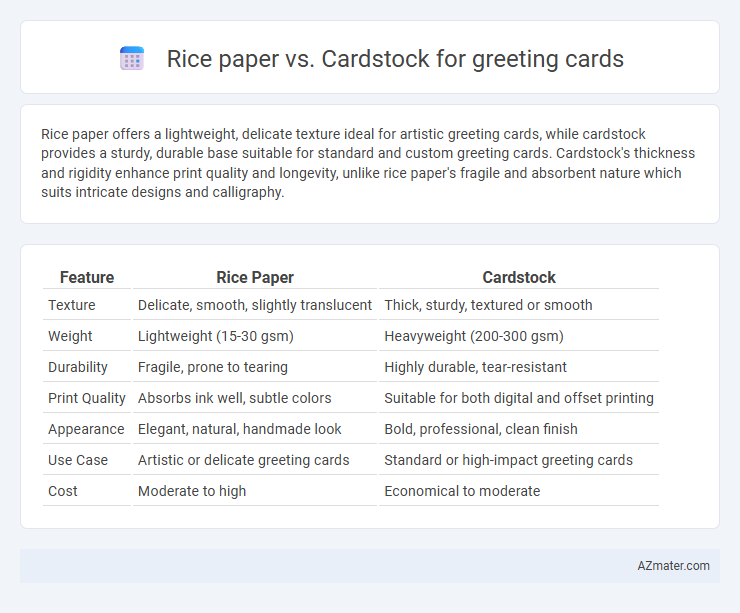Rice paper offers a lightweight, delicate texture ideal for artistic greeting cards, while cardstock provides a sturdy, durable base suitable for standard and custom greeting cards. Cardstock's thickness and rigidity enhance print quality and longevity, unlike rice paper's fragile and absorbent nature which suits intricate designs and calligraphy.
Table of Comparison
| Feature | Rice Paper | Cardstock |
|---|---|---|
| Texture | Delicate, smooth, slightly translucent | Thick, sturdy, textured or smooth |
| Weight | Lightweight (15-30 gsm) | Heavyweight (200-300 gsm) |
| Durability | Fragile, prone to tearing | Highly durable, tear-resistant |
| Print Quality | Absorbs ink well, subtle colors | Suitable for both digital and offset printing |
| Appearance | Elegant, natural, handmade look | Bold, professional, clean finish |
| Use Case | Artistic or delicate greeting cards | Standard or high-impact greeting cards |
| Cost | Moderate to high | Economical to moderate |
Introduction: Rice Paper vs Cardstock for Greeting Cards
Rice paper offers a delicate, translucent texture that enhances the elegance of greeting cards, making them ideal for artistic or vintage designs. Cardstock provides a thick, durable surface perfect for vibrant printing and structural integrity, ensuring longevity and a high-quality feel. Choosing between rice paper and cardstock depends on the desired aesthetic, durability, and printing technique for the greeting card project.
Material Composition and Texture
Rice paper is made from natural fibers like mulberry bark, resulting in a lightweight, delicate texture with a slightly translucent and textured surface, ideal for artistic greeting cards that emphasize an organic feel. Cardstock is composed of thick, sturdy paper pulp, offering a smooth or slightly textured finish with high durability, making it suitable for durable and professional-looking greeting cards. The choice between rice paper and cardstock depends on the desired tactile experience and card longevity.
Visual Appeal and Finish
Rice paper offers a delicate, translucent texture that enhances the visual appeal of greeting cards with a soft, organic finish, making designs appear elegant and artisanal. Cardstock provides a sturdier, matte or glossy finish with vibrant color reproduction, delivering a polished and professional look that is ideal for bold graphics and detailed prints. The choice depends on whether the goal is a subtle, tactile experience or a durable, vividly finished card.
Durability and Longevity
Rice paper offers a delicate texture but lacks the durability and longevity of cardstock, as it is prone to tearing and yellowing over time. Cardstock provides superior strength and resilience, maintaining its form and color longer under various environmental conditions. For greeting cards intended to be keepsakes, cardstock ensures better preservation and resistance to wear.
Print Compatibility and Ink Absorption
Rice paper offers delicate texture with moderate ink absorption suitable for water-based inks, ideal for intricate designs but less compatible with heavy ink layers or digital printing. Cardstock features a thicker, durable surface with excellent ink absorption, supporting various printing techniques including laser, inkjet, and offset, which ensures vibrant colors and sharp details. For greeting cards requiring vivid prints and durability, cardstock provides superior print compatibility and ink absorption compared to rice paper.
Folding and Crafting Ease
Rice paper offers delicate flexibility and a lightweight texture, making it ideal for intricate folds but prone to tearing if handled too aggressively. Cardstock provides superior sturdiness and resistance to creasing, ensuring clean and precise folds suitable for complex card designs. Choosing between rice paper and cardstock depends on the desired balance between elegance and durability in greeting card crafting.
Weight and Mailing Considerations
Rice paper is significantly lighter than cardstock, making it more cost-effective for mailing due to lower postage fees. Cardstock offers greater durability and rigidity, providing better protection to the greeting card during transit but increasing overall mailing weight. Choosing between rice paper and cardstock depends on balancing lightweight mailing costs against the need for sturdiness and presentation quality.
Cost Comparison
Rice paper for greeting cards generally costs less than cardstock due to its lightweight and thin material, making it an economical choice for bulk projects. Cardstock, typically thicker and more durable, comes at a higher price point but offers enhanced quality and sturdiness, which can justify the additional investment for premium or long-lasting cards. The cost difference varies based on paper weight, brand, and finish, with rice paper ranging from $0.05 to $0.15 per sheet and cardstock commonly priced between $0.20 and $0.60 per sheet.
Environmental Impact and Sustainability
Rice paper is biodegradable and made from natural fibers, offering a more sustainable option compared to traditional cardstock, which often relies on wood pulp and involves intensive energy consumption. Its production requires less water and chemicals, reducing the overall environmental footprint. While cardstock can be recycled, rice paper's compostability and renewable sourcing make it a greener choice for eco-conscious greeting cards.
Choosing the Best Paper for Your Greeting Cards
Rice paper offers a delicate, translucent texture ideal for artistic and lightweight greeting cards, enhancing a handcrafted, elegant appearance. Cardstock provides durability and thickness, making it perfect for sturdy, long-lasting cards that withstand mailing and handling. Selecting the best paper depends on the card's intended use, with rice paper favored for decorative designs and cardstock chosen for structural integrity and vivid print quality.

Infographic: Rice paper vs Cardstock for Greeting card
 azmater.com
azmater.com